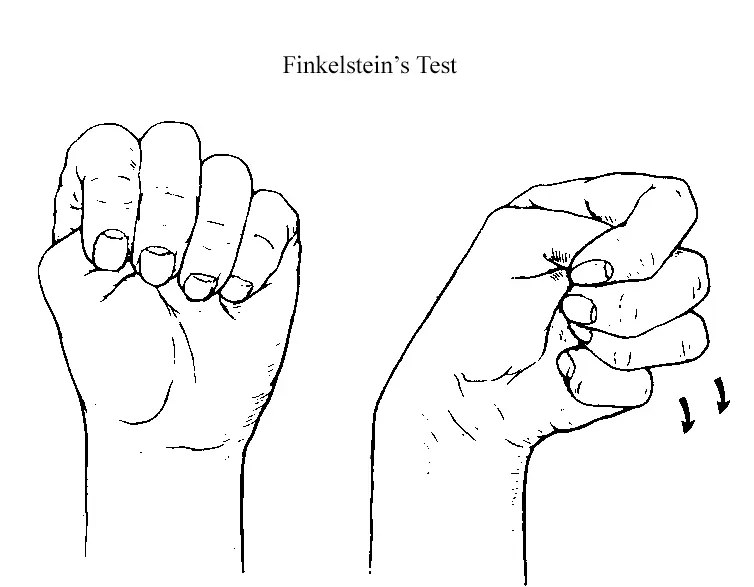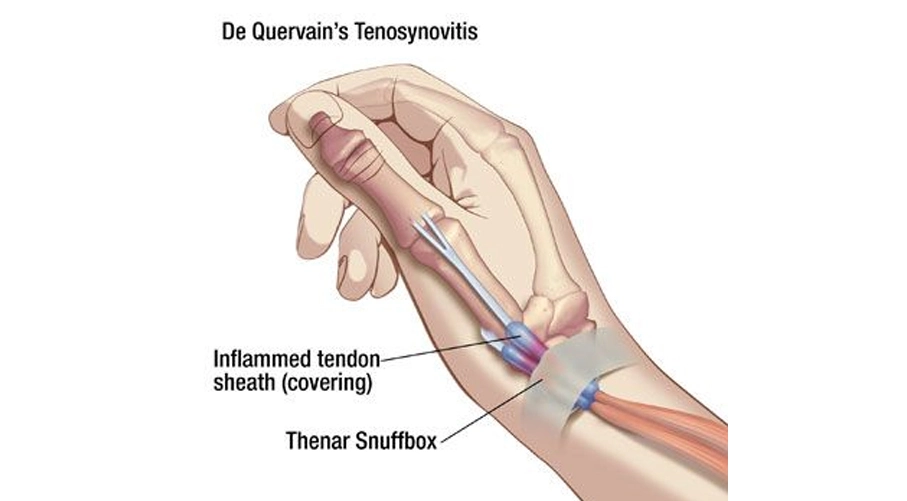De Quervain’s Tenosynovitis: Symptoms and Treatment
Introduction
De Quervain’s tenosynovitis (also known as Mother’s thumb) is a painful condition that affects the tendons located on the thumb side of the wrist. It is caused by inflammation or degeneration of the sheath surrounding the tendons of the abductor pollicis longus (APL) and extensor pollicis brevis (EPB), which are responsible for thumb movement. The condition is most commonly associated with repetitive hand or wrist movements and can affect individuals who engage in activities involving gripping, pinching, or lifting.
Symptoms of De Quervain’s Tenosynovitis
The hallmark symptom of De Quervain’s tenosynovitis is pain and tenderness at the base of the thumb, which may extend to the lower part of the forearm. Other symptoms include:
- Pain with thumb movement: Any movement that involves gripping, grasping, or pinching can exacerbate the pain.
- Swelling near the base of the thumb: Swelling may be present along the wrist, and in some cases, a visible lump or thickening of the tendon sheath can occur.
- Reduced range of motion: Pain and swelling may limit thumb and wrist mobility, making it difficult to perform everyday tasks.
- A catching or snapping sensation: Some individuals report a sticking sensation when moving the thumb, caused by the inflamed tendons catching on the surrounding tissue.
Causes and Risk Factors
De Quervain’s tenosynovitis is primarily caused by overuse or repetitive strain on the tendons. Common activities that may lead to the condition include:
- Repetitive gripping or pinching motions
- Lifting a child or heavy objects
- Participating in activities that involve wrist movement, such as tennis, gardening, or knitting
However, there are additional, lesser-known factors that may increase the likelihood of developing this condition:
- Hormonal changes in women: Hormonal fluctuations, particularly during pregnancy and the postpartum period, can trigger De Quervain’s tenosynovitis. This condition is sometimes referred to as “mother’s thumb” or “mommy wrist” due to its frequent occurrence in new mothers. Hormonal changes, including increases in relaxin and estrogen, can lead to ligament laxity and make tendons more prone to injury and inflammation. As a result, women may develop this condition during pregnancy or postpartum.
- Autoimmune conditions: There is a potential link between De Quervain’s tenosynovitis and autoimmune diseases such as rheumatoid arthritis. Inflammation from these conditions can increase the risk of tendon involvement.
- Degenerative changes: Despite the “itis” suffix, not all cases of De Quervain’s involve inflammation. Research suggests that in some cases, degenerative changes in the tendons may be a factor, which could explain why anti-inflammatory treatments may not always be fully effective.
Gender Differences
Women are more prone to developing De Quervain’s tenosynovitis compared to men. Studies suggest that women are up to three times more likely to experience this condition. This higher prevalence is largely due to hormonal changes and the repetitive hand and wrist motions involved in tasks such as child care. In contrast, men typically develop this condition due to repetitive strain from manual labor or sports, without the influence of hormonal factors.
Diagnosis


De Quervain’s tenosynovitis is typically diagnosed based on a physical examination and medical history. One of the most common tests is the Finkelstein test, in which the patient makes a fist with the thumb tucked inside the fingers and bends the wrist toward the little finger. If this movement causes sharp pain on the thumb side of the wrist, it is a strong indication of De Quervain’s tenosynovitis.
Treatment Options
Treatment for De Quervain’s tenosynovitis focuses on reducing pain, improving function, and preventing recurrence. A combination of conservative and medical interventions is often recommended.
- Rest and Activity Modification
Avoiding activities that aggravate the condition is essential for allowing the tendons to heal. Immobilizing the thumb and wrist with a splint may help prevent further irritation. - Cold Therapy
Applying ice to the affected area can help reduce swelling and numb the pain. It is advisable to apply ice for 15-20 minutes several times a day. - Non-Steroidal Anti-Inflammatory Drugs (NSAIDs)
Over-the-counter medications like ibuprofen or naproxen can help relieve pain and reduce inflammation. - Physical Therapy
A physical therapist may recommend exercises to strengthen the muscles around the thumb and wrist, improve range of motion, and reduce the risk of recurrence. Soft tissue therapy or manual techniques to release tension in the tendons may also be used. - Corticosteroid Injections
In cases where conservative treatments are not effective, corticosteroid injections may be administered to reduce inflammation. This treatment is generally very effective, with significant pain relief in most cases. - Chiropractic Care
Chiropractors can help with De Quervain’s tenosynovitis by using a variety of non-invasive techniques aimed at reducing pain, promoting tendon healing, and restoring function:- Joint Manipulation and Mobilization: Gentle adjustments to the wrist and thumb joints can help alleviate pressure on the tendons and improve mobility.
- Soft Tissue Therapy: Techniques like myofascial release or trigger point therapy can reduce muscle tension and inflammation.
- Cold and Heat Therapy: Chiropractors may use alternating cold to reduce inflammation and heat to improve blood circulation, speeding up recovery.
- Kinesiology Taping: Applying kinesiology tape helps support the wrist and thumb, reducing strain and aiding in recovery.
- Exercise Prescription: Chiropractors may recommend specific exercises to strengthen the muscles around the thumb and wrist.
- Ergonomic Advice: Adjusting daily activities to avoid further tendon irritation is an essential part of chiropractic care.
- Surgery
If symptoms persist despite conservative treatment, surgery may be recommended. The surgical procedure, known as tendon release, involves making a small incision to release the tendon sheath, reducing pressure and allowing the tendons to move freely. Surgery is typically considered only after other treatments have failed.
Prevention
Preventing De Quervain’s tenosynovitis involves minimizing repetitive thumb and wrist movements, especially in high-risk activities. Stretching exercises, ergonomic modifications, and regular breaks from repetitive tasks can all help reduce the risk. For individuals who have previously experienced the condition, continuing exercises to strengthen the wrist and thumb muscles may prevent recurrence.
Conclusion
De Quervain’s tenosynovitis is a common condition that can significantly impact hand and wrist function. Early diagnosis and treatment are essential for alleviating pain and restoring mobility. Conservative treatments are usually effective, but in severe cases, surgery may be required. Understanding the underlying causes, such as hormonal changes or autoimmune conditions, can help tailor treatment and prevention strategies for those at higher risk.
